KEY POINTS
- Electricity meters measure a household’s electricity consumption.
- Your energy retailer will use your electricity meter to calculate your energy bill.
- The three different types of electricity meter are: smart meter, accumulation meter and interval meter.
Electricity meters measure a property’s electricity consumption and are used by energy companies to calculate what to charge on your power bill. There are many different types of electricity meters in Australia, and the type you have will impact the way your retailer charges you for power.
In this Canstar Blue guide we’ll explain the different types of electricity meters available in Australia and how they work. We’ll also share some tips around how to read the different meter types.
On this page:
Types of electricity meters in Australia
There are three main types of electricity meters in Australia, and the type of meter you have can have a huge impact on your energy costs – and your wallet. The types of electricity meters in Australia are:
- Smart meter
- Accumulation meter
- Interval meter
Read on for an explanation of each meter type.
Smart electricity meters explained
Smart meters, also known as digital meters, are the latest in energy metering, providing a more accurate reading of a property’s energy consumption—and a more accurate bill for you (goodbye, estimated bills). They record electricity usage in 30 minute intervals allowing different rates to be charged at different times of day. In some parts of Australia, your smart meter may even be referred to as an interval meter—the difference, however, is that smart meters can be remotely read without a meter reader having to visit your property. You can read more in our in-depth guide to smart meters and their advantages here.
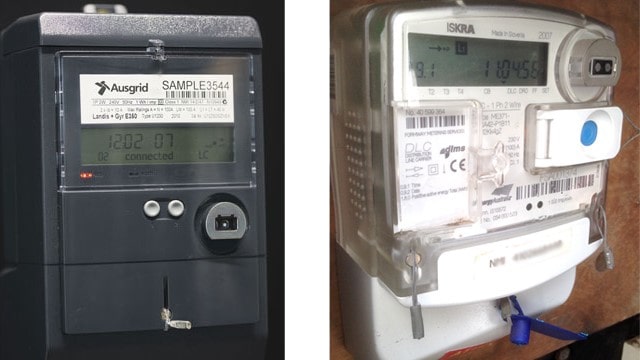
Image source: Ausgrid
How to read a smart meter
Smart meters display your usage in kWh on a digital screen, sending live electricity usage information to your energy distributor. Not only does this eliminate the need for a meter reader, customers may be able to track individual usage through an energy monitor or online portal. Smart readers also provide valuable insight into your usage, helping you identify where you can save power and reduce your bill.
Accumulation meters explained
Accumulation meters, also known as basic or flat electricity meters, measure how much electricity has been consumed by your property over a period of time. Accumulation meters can’t tell exactly when electricity has been used, so customers are charged the same rate for electricity regardless of the time of day that power is used. Customers may also choose a ‘block rate tariff’ depending on the distributor. These tariffs charge different rates depending on how much electricity you’ve used.
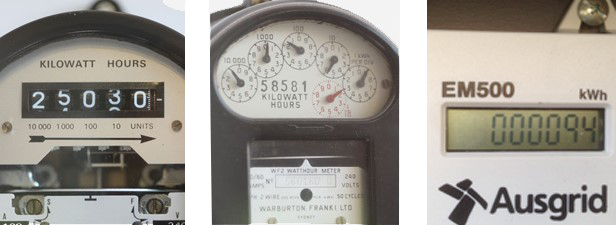
Image source: Ausgrid
How to read an accumulation meter
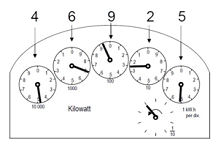
There are three types of accumulation meter displays (pictured above left to right); Cyclometer display, dial display and digital display. Digital and cyclometer displays are arguably the easiest to read—the display simply shows how much electricity has been used in kilowatt hours (kWh).
Dial accumulation meters are slightly more complicated. These electricity meters have five small dials numbered 0 to 9. To take a reading, read the numbers each dial hand falls on from left to right. If the hand falls between two numbers, then record the lowest number (unless it falls between 0 and 9, write down 9). The meter dials in the illustration on the right show a consumption of 46,925 kWh. The red dial can be ignored.
Accumulation electricity meters require a meter reader to come to the property every three months to check how much electricity has been used. This is done by calculating the difference between your current and your previous meter reads. Some energy retailers choose to offer monthly billing, in which case you will receive estimated bills between meter reads.
Interval meters explained
Manually Read Interval Meters (MRIM) record electricity usage every 30 minutes. This means power retailers can charge you different rates depending on the time of the day you use electricity. In this case, you may be charged with a time of use tariff. Time of use tariffs can charge customers low rates during off-peak times, such as late at night. But the trade-off is that you’re charged very high rates during peak demand times, often in the early evening. Even if you have an interval meter, you can still opt to be charged on a flat rate or block rate if you’re not comfortable with paying different prices for different times of day, but it’s worth discussing this option with your energy provider first, to ensure you’re on the best rate for your usage.
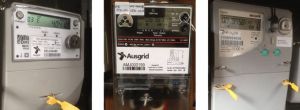
Image source: Ausgrid
How to read an interval meter
Interval meters are digital, so they’re pretty straightforward to read. If you want to estimate your next bill, then you’ll need to make a habit of jotting down the kWh figures displayed. Meter readers record interval meter data by attaching an optical probe which takes the interval meter data and then sends it to the distributor’s systems. The distributor then processes the data up to 10 times to ensure its accuracy before sending it to your retailer for billing.
Compare energy plans
While you are learning about electricity meters, it might be worthwhile looking at your current electricity plan and comparing to others on the market. You can visit the Canstar Blue comparison tool and enter your postcode or check out some energy plans below.
Here are some sponsored deals from the retailers on our database that include a link to the retailer’s website for further details. These are products from referral partners†. These costs are based on the Ausgrid energy network in Sydney but prices may vary depending on your circumstances. This comparison assumes general energy usage of 3900kWh/year for a residential customer on a single rate tariff. Please use our comparison tool for a specific comparison in your area and to see other products in our database that may be available. Our database may not cover all deals in your area. As always, check all details of any plan directly with the retailer before making a purchase decision.
|
21% Less than reference price |
$1,435 Price/year (estimated) |
Go to Site |
Here are some sponsored deals from the retailers on our database that include a link to the retailer’s website for further details. These are products from referral partners†. These costs are based on the Citipower network in Melbourne but prices may vary depending on your circumstances. This comparison assumes general energy usage of 4000kWh/year for a residential customer on a single rate tariff. Please use our comparison tool for a specific comparison in your area and to see other products in our database that may be available. Our database may not cover all deals in your area. As always, check all details of any plan directly with the retailer before making a purchase decision.
 |
|
10% Less than VDO |
$1,304 Price/year (estimated) |
Go to Site |
Here are some sponsored deals from the retailers on our database that include a link to the retailer’s website for further details. These are products from our referral partners†. These costs are based on the Energex network in Brisbane but prices may vary depending on your circumstances. This comparison assumes general energy usage of 4600kWh/year for a residential customer on a single rate tariff. Please use our comparison tool for a specific comparison in your area and to see other products in our database that may be available. Our database may not cover all deals in your area. As always, check all details of any plan directly with the retailer before making a purchase decision.
 |
|
9% Less than reference price |
$1,888 Price/year (estimated) |
Go to Site |
Here are some sponsored deals from the retailers on our database that include a link to the retailer’s website for further details. These are products from our referral partners†. These costs are based on the SA Power network in Adelaide but prices may vary depending on your circumstances. This comparison assumes general energy usage of 4011kWh/year for a residential customer on a single rate tariff. Please use our comparison tool for a specific comparison in your area and to see other products in our database that may be available. Our database may not cover all deals in your area. As always, check all details of any plan directly with the retailer before making a purchase decision.
 |
|
9% Less than reference price |
$2,036 Price/year (estimated) |
Go to Site |
Solar meters explained
If you’ve installed a solar PV system or storage battery then you’ll need a two-way or bidirectional electricity meter that can measure both incoming electricity and solar electricity being exported to the grid in exchange for a ‘feed-in tariff’. Most modern interval meters are also bidirectional, as are virtually all new smart meters. If you have a dial or cyclometer accumulation electricity meter however, then you will require a meter upgrade to accurately measure your power exports.
You may also be interested in:
Which type of electricity meter is best?
If you’re considering building a new home, then you’ll likely be recommended to install a smart meter. In fact, the Australian Energy Market Commission (AEMC) has recommended a 100 per cent uptake of smart meters by 2030, so installing a smart meter now will prevent additional costs to upgrade your meter in the near future.
If you live in a property that’s already built and have an accumulation meter, then it may be worth upgrading your meter if:
- You’re installing solar
- You want a ‘time of use’ tariff
- You want access to live electricity monitoring
Check with your energy provider to see what’s possible in your location, and then ask about costs. In some states, upgrading your meter can cost anywhere from $250 to $1,000, and the installation process might disrupt your power supply. If you’re not sure you can front the installation cost, some retailers offer smart meter upgrades that can be repaid incrementally – the cost rolled into your electricity bills.
Original reporting by Brendon O’Neill
Image Source: Sunshine Studio/Shutterstock.com
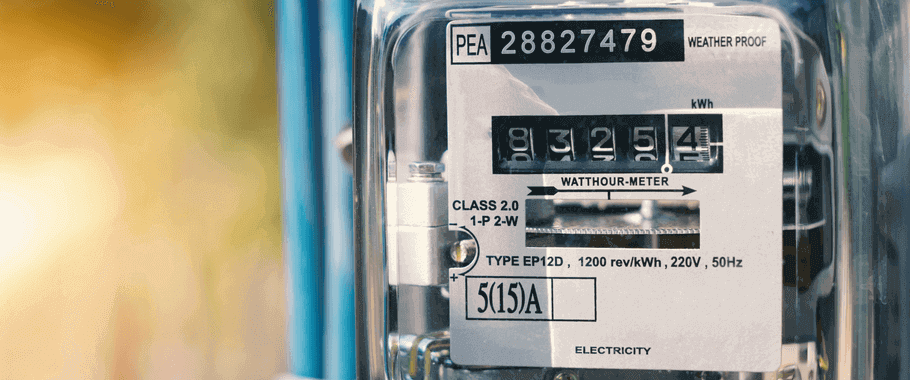


Share this article